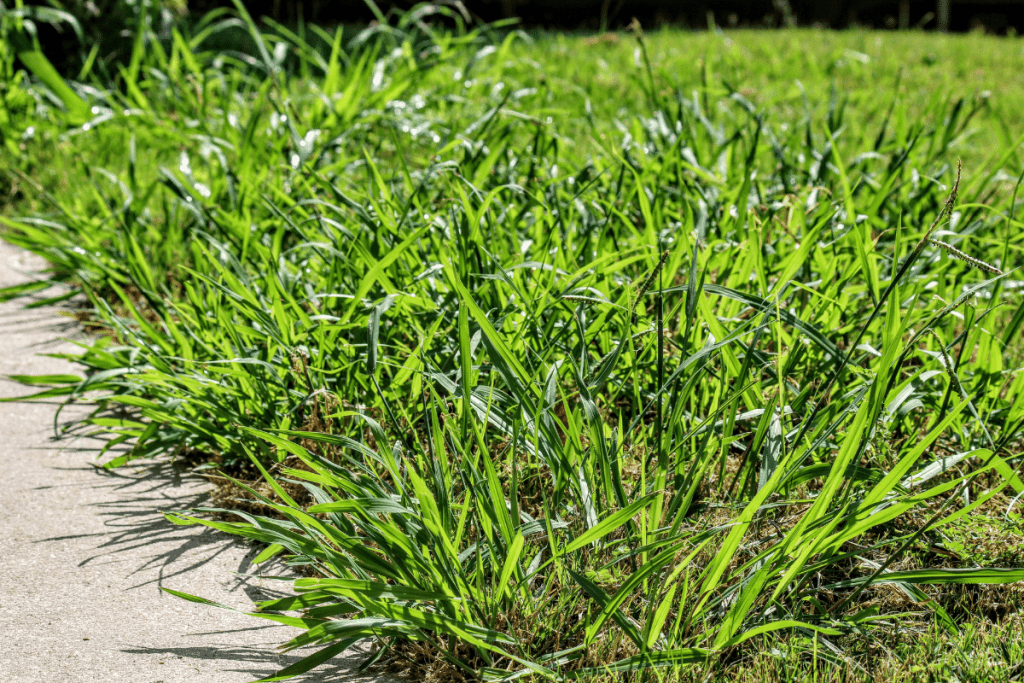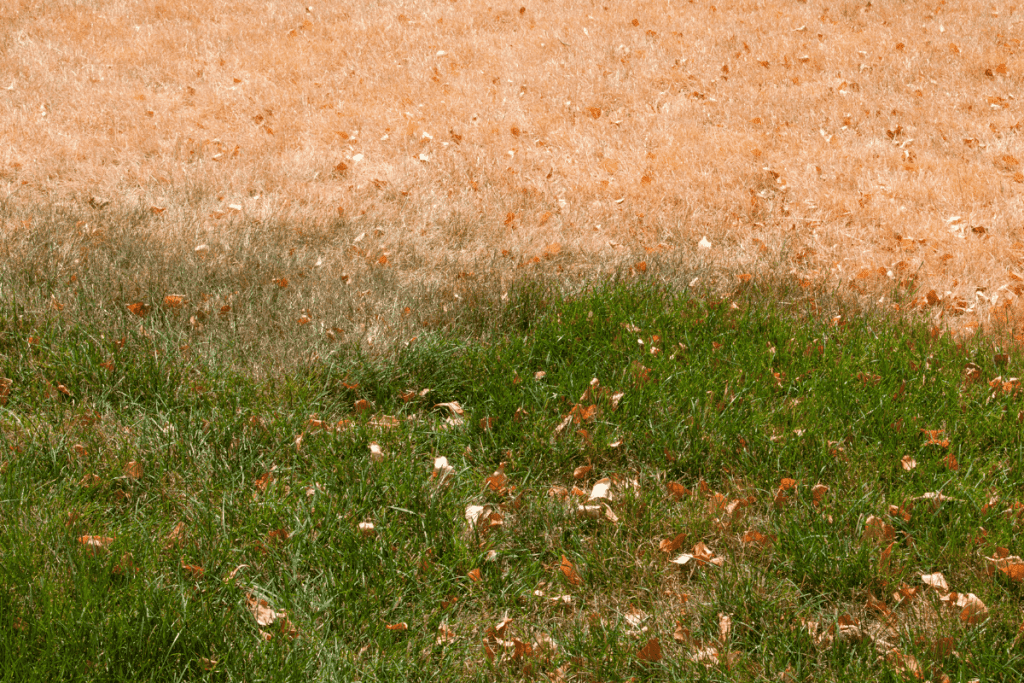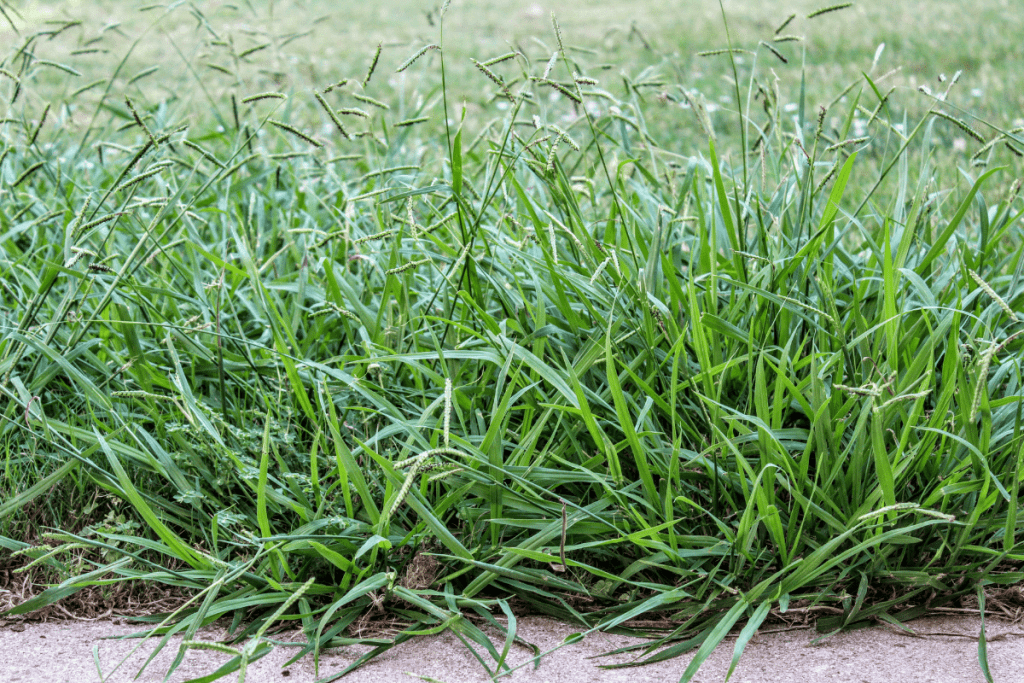There’s nothing more frustrating than finding a plethora of crabgrass plants that have taken root in your lawn.
If we don’t use a pre-emergent in the late fall or our treatment doesn’t take, crabgrass has the opportunity to take hold.
We all want healthy, lush lawns, and crabgrass does not make for a beautiful lawn.
The best way to control crabgrass is through pre-emergent treatments.
If crabgrass has already taken hold in your yard, it is, unfortunately, a bit more complicated.
Luckily, it is possible to get rid of crabgrass and have a beautiful lawn this summer.
Some sure-fire ways to get rid of crabgrass in the summer include:
- Pullcrabgrass seed up by hand.
- Wait until the after some colder weather to use pre-emergent weed control.
- Use post-emergent weed control to kill established crabgrass.
- Hire a lawn care professional.
Crabgrass is a stubborn, unwanted guest on any lawn.
We’ll give you all the information you need to successfully rid your lawn of pesky crabgrass.

Table of Contents
How To Get Rid Of Crabgrass In The Summer
Crabgrass is a stubborn and pervasive weed.
It doesn’t need much in the way of resources like fertilizer, water, and care to establish and thrive in your lawn.
Unfortunately, we don’t want it to exist on our property at all, especially in our otherwise healthy turf.
Getting rid of crabgrass once it establishes itself is a tricky business.
It is a resilient weed capable of surviving harsh circumstances.
The best time to treat your lawn for crabgrass is when the flowers and trees first start to bloom in the early spring.
This is a tell-tale indicator of the beginning of the growing season.
In the early spring, taking action against crabgrass is your best chance of eliminating crabgrass from your yard.
Pre-emergents are great for promoting the overall health of your lawn.
They are easily applied and help stop crabgrass seeds in their tracks before they establish themselves.
Even if you miss the spring deadline for applying pre-emergents, there are other ways to get rid of the crabgrass in your lawn.
Waiting until summer does give the crabgrass time to take root, but you still have a chance of getting rid of it for good.
Summertime offers the ideal growing conditions for plants to grow.
The combination of heat and sun leads to a prolific time of growth in plants and grasses.
Unfortunately, these same conditions give crabgrass a chance to become strong and ample on your lawn.
Weed Crabgrass By Hand
One way to get rid of crabgrass is by pulling up the crabgrass by hand.
It might seem daunting to pull every single crabgrass plant out of your yard.
It is a labor-intensive option.
This is especially true if you have a large yard or lots of crabgrass plants.
Pulling every crabgrass plant out of the ground is also a difficult endeavor.
You need to pull out the entire plant with the root to eliminate it successfully.
Due to the labor-intensive nature of this option, we don’t recommend this with a lot of crabgrass.
It takes a lot of time and energy to individually weed each plant by hand if you have a lot of space to take care.
Save yourself some time and frustration and use another option if the crabgrass problem is severe or if you have a large property.
Overseeding Bald Patches

Once you successfully pull out the entirety of every crabgrass plant, you’ll need to fill in the bald patches left.
Crabgrass is a highly opportunistic plant.
It is eager to take advantage of any free space on your lawn.
Filling in the spaces quickly helps ensure you won’t have the pesky weeds returning quickly.
You need to spread ample amounts of seed into the patch to overseed.
Make sure to overlap the edges of the bald patch to make a seamless fit.
Use this opportunity to use a combination product for overseeding.
These products often include fertilizer, mulch for water retention, and herbicide to prevent other weeds from taking the space intended for the grass seed.
Be Patient And Try Again Next Year
If you are not too particular about appearances, there is always the option of just waiting until next year.
Crabgrass dies over the winter as it is an annual weed.
It will only come back if the thousands of seeds produced by the crabgrass have the opportunity to take root next spring.
If you wait out the summer and fall, the crabgrass will die over the winter.
When spring hits again, applying a pre-emergent will keep the crabgrass from taking root again.
Being patient is sometimes hard, especially when enjoying our lawns in the summer.
Chances are you’ll only have to make the mistake of not applying pre-emergent once to know how much better off it leaves you and your lawn.
It is an easy option to allow nature to run its course and kill off the pesky weeds.
If you want better grass now, this is not your option.
If you choose this method to get rid of unwanted weeds, we recommend staying on top of the other aspects of lawn care maintenance.
Keeping your lawn healthy and strong will give it a much better chance of choking out the crabgrass next year, especially with the help of a pre-emergent applied in the spring.
Make sure to stay on top of lawn care by regularly doing the following:
- Mowing to an adequate height. It also helps to allow grass clippings to stay on the lawn to redistribute vital nutrients into the soil.
- Watering regularly to keep grass from yellowing or burning in the summer heat.
- Fertilizing the lawn regularly to keep it healthy and strong. Resilient grass stands the best chance against invasive weeds and unwanted pests or diseases.
Post-Emergent Weed Control
Post-emergent weed control takes care of established and mature weeds.
It is a chemical treatment used to kill crabgrass.
In many cases, it takes multiple applications of the post-emergent herbicide to fully eradicate the crabgrass problem.
There are many different post-emergent crabgrass killers.
Many of them also kill broadleaf weeds, which is an added benefit if they grow in your healthy grass.
Keep in mind some jurisdictions restrict what types of post-emergent weed control options you may use as a homeowner.
In some cases, lawn care professionals are the only ones allowed to use these chemicals.
Make sure to check your local guidelines.
Most of these guidelines and rules are in place to prevent contamination of water sources through runoff.
Another thing to keep in mind with post-emergent weed control options is the chance of damaging the grass on your lawn.
Some crabgrass killers may also damage your lawn.
This is especially true for more vulnerable types of grass.
Make sure to follow directions carefully to keep dilution levels adequate.
If the concentration is too strong, you may damage your lawn and have a bigger problem than crabgrass on your hands.
Check out these other ways to kill weeds so they don’t come back.
Hire A Professional
Hiring a professional is the most sure-fire way to get rid of a crabgrass infestation this summer.
Lawn care experts are seasoned and experienced in getting rid of crabgrass at all times of the year.
In many cases, this may be your best option, especially if the crabgrass problem on your property is severe and expansive.
Many crabgrass killers require multiple applications to fully eradicate the pesky weeds.
To completely get rid of crabgrass in the summer, you must kill the established crabgrass.
You’ll need to have the lawn care professionals complete multiple applications to kill crabgrass as it continues to emerge with the germination of crabgrass seeds.
Post-emergents will not kill off the thousands of crabgrass seeds if they have yet to germinate.
This is why you need multiple applications of the post-emergent crabgrass killer to fully eliminate crabgrass in the summer.
How To Keep Crabgrass From Coming Back

Once you get rid of the crabgrass in your yard, you’ll undoubtedly want to do everything possible to keep it from coming back next year.
In many ways, crabgrass is extremely stubborn and resilient.
It survives in harsh conditions and doesn’t need much to establish itself and thrive.
The best way to keep crabgrass from coming back is by maintaining optimal health for our lawns and applying a pre-emergent to the lawn in the early spring.
Healthy lawns are lush and dense, making it much more difficult for pesky weeds to infiltrate.
Crabgrass takes advantage of patchy lawns and weak grass.
Because it is strong and resilient, it will overtake unhealthy grass.
Limiting the number of bald patches in your lawn will decrease the opportunities for crabgrass to take root.
Keep your yard dense by mowing regularly.
It also helps to keep the grass clippings on the lawn.
When the grass clippings degrade, they release vital nutrients back into the soil and feed your lawn.
Other ways to keep your lawn healthy include routine mowing to an adequate height to promote thick and dense growth.
Regular fertilization is also vital for overall lawn health.
It is also essential to keep up on watering your lawn regularly to not get burnt up in the summer.
Burnt grass tends to have more patches for crabgrass to grow.
If any patches occur, make sure to overseed and treat the spots as they come.
This will keep your lawn lush and dense and limit any opportunities for crabgrass to creep in.
Prevention Is Key
In general, preventing crabgrass is the best way to get rid of it completely.
Treating crabgrass once it is established is expensive and labor-intensive.
You don’t want to spend a bunch of time, energy, and money fixing a problem you could have easily prevented with proper lawn care and maintenance.
Pre-emergents are the best way to kill crabgrass seedlings in the early spring and stop crabgrass germination from happening at all.
One of the best ways to prevent crabgrass is by keeping your lawn as healthy as possible.
This includes regular lawn maintenance as well as annual aeration.
Aeration plays a key role in soil health.
It allows adequate space for air and water to absorb into the soil.
This keeps the soil healthy.
This way, the grass roots have access to all the water and nutrients needed to foster healthy and strong growth.
Learn more about aeration in our guide on how to aerate a lawn.
Another essential form of crabgrass prevention is overseeding and treating bald patches.
The idea is to eliminate any opportunity for crabgrass to take root.
It is also an effective weed control option as thick lawns crowd out weeds.
Make sure to treat every patchy area as it occurs by overseeding.
If you apply an herbicide to your lawn, you must wait at least a month to spread seeds.
Grass seeds are vulnerable to being killed by herbicides and won’t grow if the conditions are not conducive to healthy germination.
Taking Care Of Crabgrass In The Fall
If you notice grassy weeds like crabgrass overtake your lawn in the fall, a few options are to consider.
While post-emergents may seem like a good idea, it is pretty late in the season to tackle such a big and often expensive undertaking.
We recommend just waiting for the winter to come to kill off the crabgrass.
By the fall, you are much closer to the winter when the weather will take care of crabgrass. Instead of spending a lot of money hiring lawn care professionals, just wait until next year.
You’ll also save yourself a lot of time and energy by waiting.
Most lawn care enthusiasts fertilize and aerate in the fall.
If you apply a post-emergent crabgrass killer, it may interfere with these other tasks.
Once the weed killer is applied to the grass, you’ll want to wait at least a week before aerating your soil or applying fertilizer.
If you are very eager to get rid of crabgrass in the fall, it is possible, but in most instances, we recommend just waiting for next spring to apply pre-emergent.